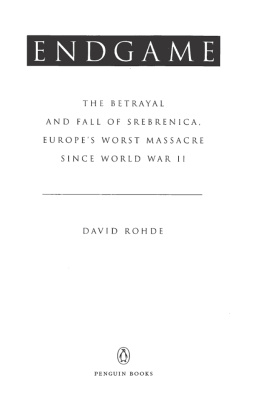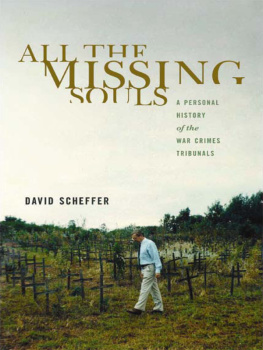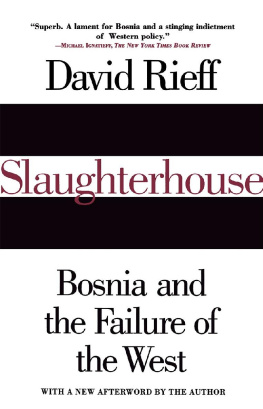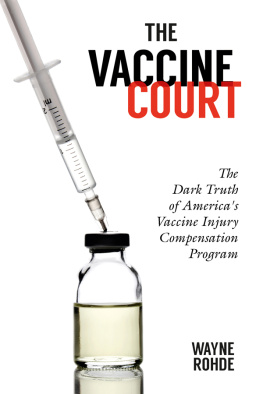Praise for Endgame
A remarkable account courageous unsparing.
The New York Times
Powerful definitive Rohde tells the Srebrenica story with all the shades of gray the truth demanded.
The Washington Post
If the shame of Srebrenicas fall has started to fade, Endgame will bring it all flooding back, a riveting reminder that General Mladi and the Serbs were strong only because Europe, the U.S., and the UN were weak. Srebrenica paid in blood; the world will be paying for years.
and the Serbs were strong only because Europe, the U.S., and the UN were weak. Srebrenica paid in blood; the world will be paying for years.
Christiane Amanpour
David Rohde is a brave reporter. Without him, this incredible story would not have been told. We all owe him a debt.
Peter Jennings
Sometimes only the dead can bring a story alive. That is certainly what has happened in the case of those Bosnians who died at Srebrenica. David Rohde listened to them. It has already earned him a Pulitzer Prize and now with Endgame it has earned him a stunning, compelling book.
Jim Lehrer
David Rohde broke the story the old-fashioned way. He followed some rumors, he followed some trails until he came to a leg protruding from the ground. He wrote the story of Srebrenica and the nation suddenly knew of the largest single killing in Europe since Jews were murdered wholesale in the Second World War.
Bill Moyers
Important and revealing.
Library Journal
A passionate account, and an important addition to the growing library of books about the Bosnian catastrophe.
Kirkus Reviews
PENGUIN BOOKS
ENDGAME
David Rohde, winner of two Pulitzer Prizes in journalism, is a foreign affairs columnist for Reuters. Previously, he worked as a reporter for The New York Times for fifteen years. He won his first Pulitzer Prize in 1996 for uncovering the Srebrenica massacre in Bosnia for The Christian Science Monitor and his second in 2009 as part of a team of New York Times reporters covering Afghanistan and Pakistan. He is also the coauthor, with Kristen Mulvihill, of A Rope and a Prayer: The Story of a Kidnapping.
ENDGAME
THE BETRAYAL
AND FALL OF SREBRENICA,
EUROPES WORST MASSACRE
SINCE WORLD WAR II

DAVID ROHDE

PENGUIN BOOKS
PENGUIN BOOKS
Published by the Penguin Group
Penguin Group (USA) Inc., 375 Hudson Street, New York, New York 10014, U.S.A.
Penguin Group (Canada), 90 Eglinton Avenue East, Suite 700, Toronto, Ontario,
Canada M4P 2Y3 (a division of Pearson Penguin Canada Inc.)
Penguin Books Ltd, 80 Strand, London WC2R 0RL, England
Penguin Ireland, 25 St Stephens Green, Dublin 2, Ireland (a division of Penguin Books Ltd)
Penguin Group (Australia), 250 Camberwell Road, Camberwell, Victoria 3124, Australia
(a division of Pearson Australia Group Pty Ltd)
Penguin Books India Pvt Ltd, 11 Community Centre, Panchsheel Park,
New Delhi 110 017, India
Penguin Group (NZ), 67 Apollo Drive, Rosedale, Auckland 0632, New Zealand
(a division of Pearson New Zealand Ltd)
Penguin Books (South Africa) (Pty) Ltd, 24 Sturdee Avenue, Rosebank, Johannesburg 2196,
South Africa
Penguin Books Ltd, Registered Offices:
80 Strand, London WC2R 0RL, England
First published in the United States of America by Farrar, Straus and Giroux 1997
Published in Penguin Books with a revised aftermath, epilogue, and postscript 2012
10 9 8 7 6 5 4 3 2 1
Copyright David Rohde, 1997, 2012
Maps copyright by David Herring, 1997
All rights reserved
LIBRARY OF CONGRESS CATALOGING-IN-PUBLICATION DATA
Rohde, David S., 1967
Endgame: the betrayal and fall of Srebrenica, Europes worst massacre since
World War II / David S. Rohde.
p. cm.
Includes bibliographical references and index.
ISBN: 978-1-101-57509-3
1. Yugoslav War, 1991 CampaignsBosnia and HercegovinaSrebrenica.
2. Yugoslav War, 1991 Atrocities. 3. Srebrenica (Bosnia and Hercegovina)
History, Military. I. Title.
DR1313.32.S68R64 1998
949.703dc21 98-26127
Printed in the United States of America
Designed by Abby Kagan
Except in the United States of America, this book is sold subject to the condition that it shall not, by way of trade or otherwise, be lent, resold, hired out, or otherwise circulated without the publishers prior consent in any form of binding or cover other than that in which it is published and without a similar condition including this condition being imposed on the subsequent purchaser.
The scanning, uploading, and distribution of this book via the Internet or via any other means without the permission of the publisher is illegal and punishable by law. Please purchase only authorized electronic editions, and do not participate in or encourage electronic piracy of copyrighted materials. Your support of the authors rights is appreciated.
ALWAYS LEARNING
PEARSON
To the people of Srebrenica
and to my family
MAPS
PREFACE
I n August 1995, while covering the war in Bosnia for The Christian Science Monitor, I heard about suspected mass graves U.S. spy planes had located near Srebrenica in eastern Bosnia. The surrounded Muslim town had fallen to the Bosnian Serbs a month earlier. Survivors reported mass executions.
On August 16, I received permission from the Bosnian Serbs to enter their territory and drive straight to Paletheir self-declared capital. With a faxed copy of the satellite photo of the suspected graves in hand, I headed in the direction of Pale but stopped instead in Nova Kasabathe village where the suspected graves were spotted. After searching for two hours, I found four swaths of fresh digging, two empty ammunition boxes, notes from a Srebrenica town meeting, an elementary school diploma with a Muslim name, and finally, a decomposed human leg.
I then spent two weeks in September searching refugee camps on the other side of the front line for survivors of mass executions. I found nine survivors who told credible stories of thousands of unarmed Muslim prisoners being shot. Soldiers who survived the trek from Srebrenica led me to the brother of the man whose elementary school diploma Id found twenty-five feet from a suspected grave in Nova Kasaba. When I showed the diploma to him, his face went blank and he turned and disappeared into a crowd of soldiers. His twenty-one-year-old brother Murat had been missing since Srebrenica fell.
In October, I reentered Serb territory without permission and found two more execution sites. At the first were three canes and a stack of civilian clothes one hundred yards from what looked like two freshly dug mass graves, corroborating survivors stories of old men and civilians being killed. At the second, human bones lay next to an earthen dam, again confirming survivor accounts of executions. Just before I took photos of the bones, a Bosnian Serb watchman arrested me.
I was convicted of illegal entry, jailed for ten days and threatened with an espionage charge that carried a sentence of ten years to death. After twelve members of my family and two of my editors at The Christian Science Monitor flew to ongoing Bosnia peace talks in Dayton, Ohio, the Clinton administration pressured the Serbs into freeing me.
At that time, I believed Srebrenicas fall to be a simple tale of victim and perpetrator. But the towns fall has proven far more complex, convoluted and darker than I expected.
The fall of Srebrenica has emerged as one of the great controversiesand mysteriesof the war in Bosnia. Countless conspiracy theories, some dubious and some plausible, revolve around the tragedy.
Next page









 and the Serbs were strong only because Europe, the U.S., and the UN were weak. Srebrenica paid in blood; the world will be paying for years.
and the Serbs were strong only because Europe, the U.S., and the UN were weak. Srebrenica paid in blood; the world will be paying for years.
